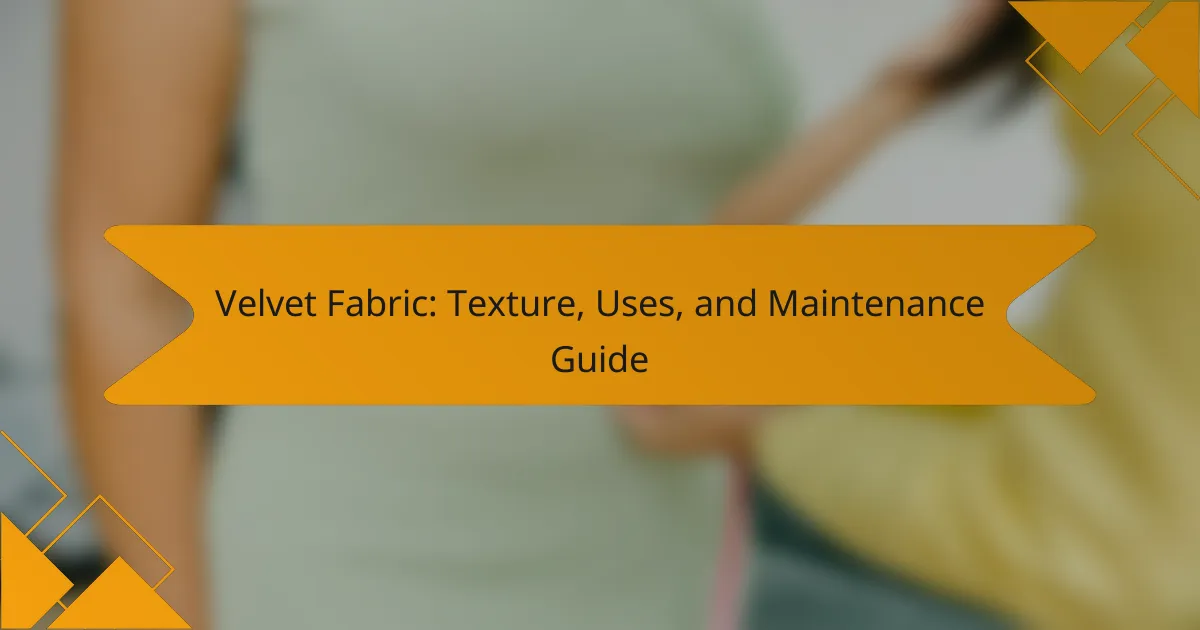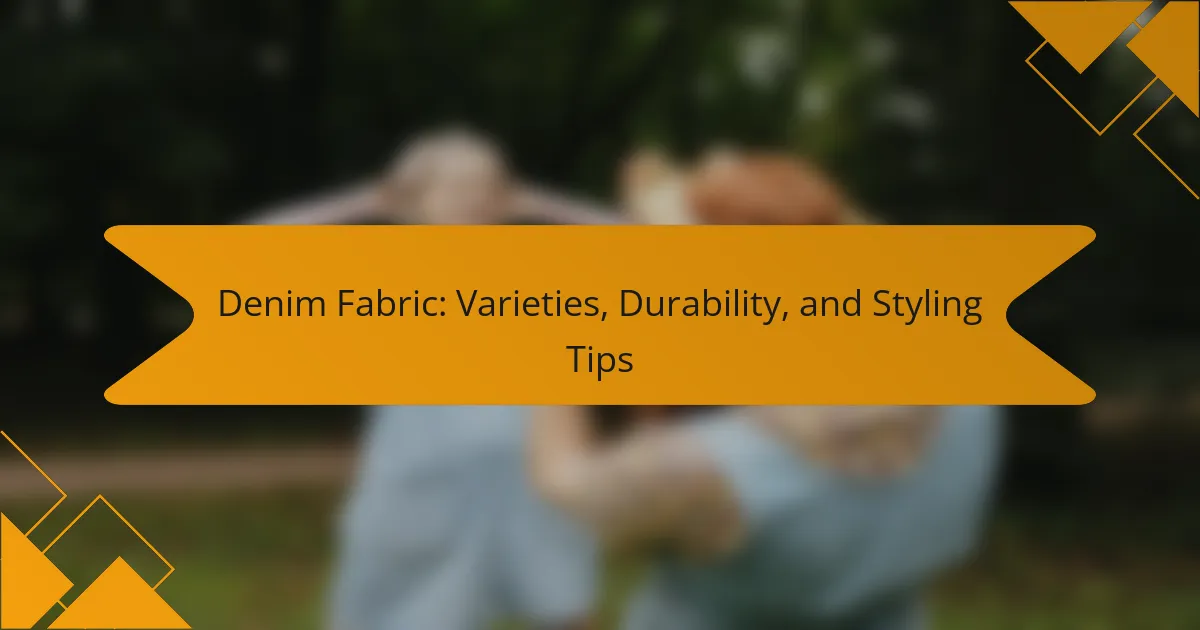Velvet fabric is a luxurious textile characterized by its soft texture and sheen, created by weaving two layers of fabric and cutting the top layer to form a dense pile. This article provides an overview of velvet’s various types, including silk, cotton, and polyester, and highlights its historical significance in fashion and upholstery. Key maintenance tips are offered, including brushing techniques, stain removal, and proper storage to preserve its appearance. Additionally, the article outlines effective methods for working with velvet, such as pre-washing, cutting, and sewing to achieve professional results.
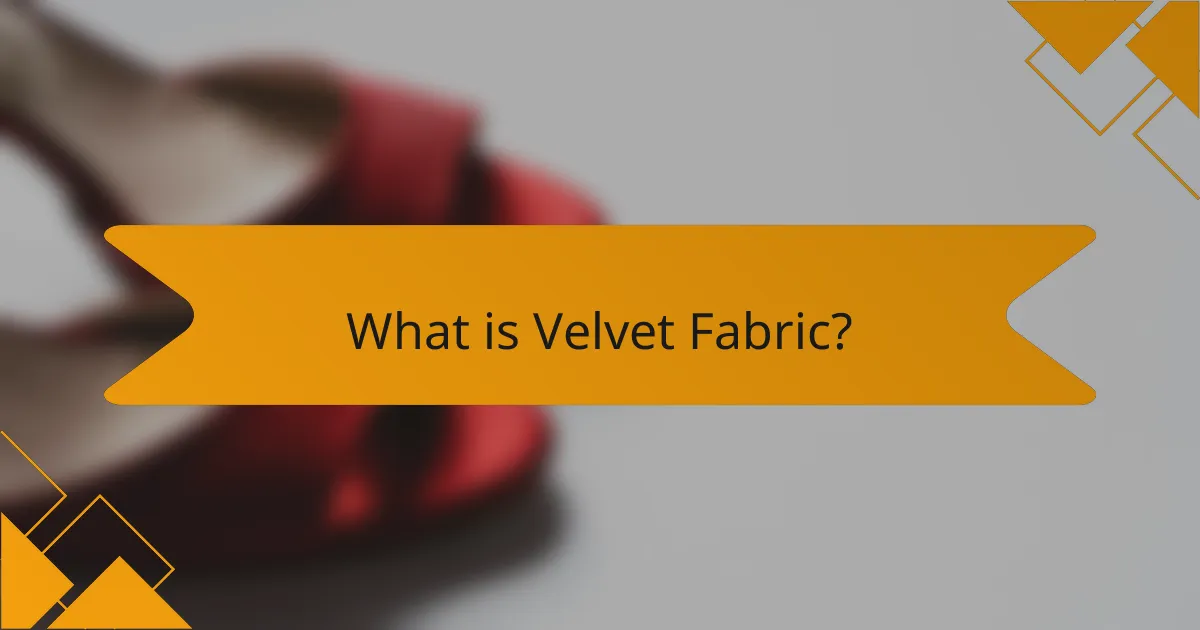
What is Velvet Fabric?
Velvet fabric is a soft, luxurious textile known for its rich texture and sheen. It is made by weaving two layers of fabric together and then cutting the top layer to create a dense pile. This unique construction gives velvet its characteristic softness and depth. Velvet can be made from various fibers, including silk, cotton, and polyester. Historically, velvet has been associated with nobility and high fashion. Its plush surface reflects light, enhancing its visual appeal. Velvet is commonly used in upholstery, clothing, and accessories. The fabric’s versatility makes it suitable for both formal and casual applications.
How is Velvet Fabric made?
Velvet fabric is made through a weaving process that creates a soft, textured surface. The production involves weaving two layers of fabric simultaneously. These layers are then cut apart to form the characteristic pile. This pile gives velvet its unique softness and sheen. Traditionally, velvet was made from silk, but now it can also be crafted from cotton, polyester, or a blend of fibers. The weaving technique used is often referred to as the “double cloth” method. Velvet production dates back to the Middle Ages, particularly in regions like Italy and the Middle East. The combination of the weaving technique and the fiber used determines the final texture and quality of the velvet.
What materials are used in the production of Velvet Fabric?
Velvet fabric is primarily made from silk, cotton, polyester, or a blend of these materials. Silk velvet is known for its luxurious feel and sheen. Cotton velvet is durable and more affordable. Polyester velvet is often used for its affordability and ease of care. Blends can offer a combination of texture and durability. The choice of material affects the fabric’s weight, texture, and appearance. For instance, silk velvet is softer, while polyester velvet is more resistant to wear.
What are the different weaving techniques for Velvet Fabric?
The different weaving techniques for velvet fabric include cut pile, loop pile, and crushed velvet. Cut pile velvet is created by cutting the loops of yarn, resulting in a soft, smooth surface. Loop pile velvet retains its loops, offering a textured finish. Crushed velvet involves twisting the fabric during the finishing process, creating a unique, wrinkled appearance. These techniques allow for various textures and appearances in velvet fabric, catering to different design needs. Each method influences the fabric’s drape, shine, and overall aesthetic.
What are the characteristics of Velvet Fabric?
Velvet fabric is a soft, luxurious textile known for its distinct texture and appearance. It features a dense pile that creates a rich, plush feel. This pile is typically made from silk, cotton, or synthetic fibers. Velvet has a unique ability to reflect light, giving it a beautiful sheen. The fabric is often used in upholstery, clothing, and accessories due to its elegance. Additionally, velvet is durable and can withstand regular use when properly cared for. It is also available in various colors and patterns, enhancing its versatility. Velvet fabric can be challenging to clean, requiring specific maintenance to preserve its quality.
How does the texture of Velvet Fabric influence its use?
The texture of velvet fabric significantly influences its use due to its softness and luxurious feel. This unique texture makes velvet ideal for upholstery, curtains, and formal wear. The plush surface provides comfort and a sense of elegance. Velvet’s texture also enhances its ability to reflect light, creating a rich visual appeal. Additionally, its thickness contributes to durability, making it suitable for high-traffic areas. The tactile quality of velvet invites interaction, which can be advantageous in fashion and interior design. Overall, the texture of velvet fabric directly impacts its aesthetic and functional applications.
What are the different types of Velvet Fabric available?
There are several types of velvet fabric available. The most common types include silk velvet, cotton velvet, polyester velvet, and crushed velvet. Silk velvet is known for its luxurious feel and sheen. Cotton velvet is softer and more durable, making it ideal for upholstery. Polyester velvet is affordable and resistant to wrinkling and fading. Crushed velvet has a unique texture created by pressing the fabric, giving it a distinctive appearance. Each type serves different purposes in fashion and interior design.
What are the common uses of Velvet Fabric?
Velvet fabric is commonly used in upholstery, clothing, and accessories. In upholstery, it adds a luxurious feel to furniture and drapery. Velvet is often chosen for sofas, chairs, and curtains due to its rich texture and appearance. In clothing, velvet is popular for formal wear, including dresses and suits. The fabric’s softness and sheen make it ideal for evening garments. Accessories like bags and shoes also frequently feature velvet for a stylish touch. Additionally, velvet is used in home décor items such as cushions and throws, enhancing aesthetic appeal. Its versatility allows for various applications in both fashion and interior design.
In which industries is Velvet Fabric most commonly utilized?
Velvet fabric is most commonly utilized in the fashion, upholstery, and automotive industries. In the fashion industry, velvet is popular for making luxurious clothing items such as dresses and jackets. Upholstery uses velvet for its rich texture, often in furniture like sofas and cushions. The automotive industry employs velvet in vehicle interiors for a premium feel. Velvet’s softness and durability make it a preferred choice across these sectors.
How is Velvet Fabric used in home decor?
Velvet fabric is used in home decor for its luxurious texture and versatility. It is commonly employed in upholstery for sofas and chairs, providing a rich appearance. Velvet curtains add elegance and depth to a room while also offering light control. Decorative pillows made from velvet enhance comfort and style on beds and sofas. Additionally, velvet can be used for table runners and throws, contributing to a sophisticated table setting. The fabric’s ability to absorb light creates a warm ambiance, making it a popular choice for cozy spaces. Velvet’s durability ensures it can withstand everyday use while maintaining its aesthetic appeal.
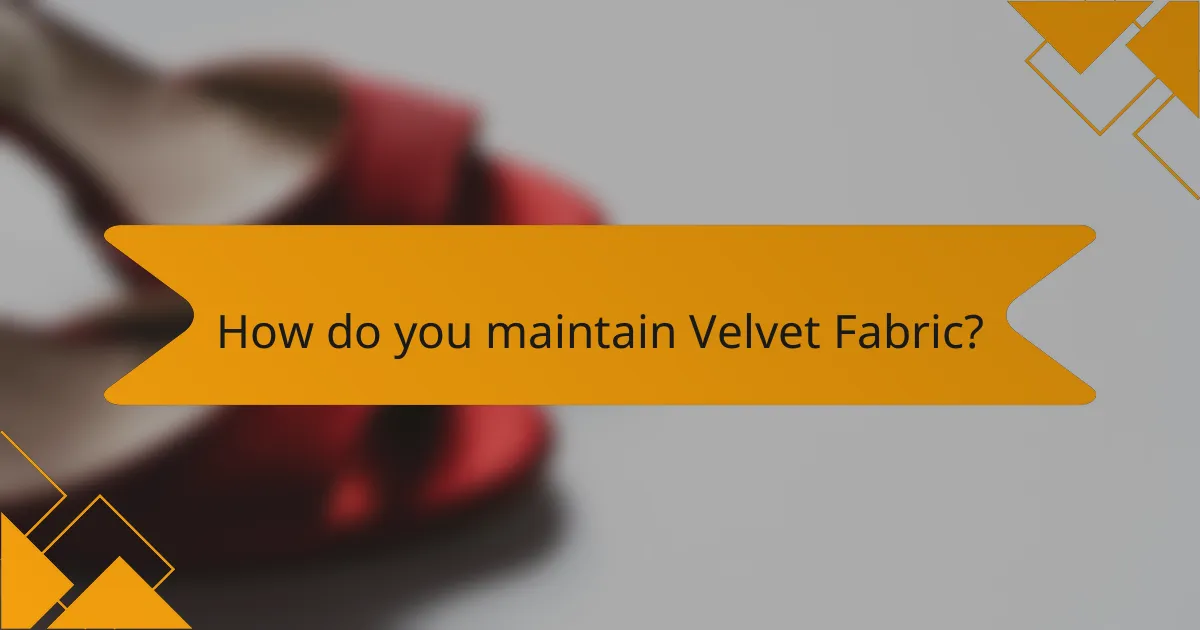
How do you maintain Velvet Fabric?
To maintain velvet fabric, regularly brush it with a soft, lint-free cloth. This helps remove dust and restore the fabric’s texture. For stains, gently blot the area with a damp cloth and mild detergent. Avoid rubbing, as this can damage the fibers. If the fabric is machine washable, use a gentle cycle with cold water. Always air dry to prevent shrinkage. Velvet should be stored in a cool, dry place away from direct sunlight. This prevents fading and maintains its luxurious appearance. Regular maintenance keeps velvet looking fresh and vibrant.
What are the best cleaning methods for Velvet Fabric?
The best cleaning methods for velvet fabric include gentle vacuuming, spot cleaning, and professional dry cleaning. Gentle vacuuming removes dust and debris without damaging the fabric. Use a soft brush attachment to avoid pulling fibers. Spot cleaning is effective for small stains. Blot the stain with a clean cloth and a mild detergent solution. Avoid rubbing, as this can damage the texture. For deeper cleaning, professional dry cleaning is recommended. This method preserves the fabric’s integrity and color. Velvet should not be washed in water, as it can lead to watermarks and distortion. Following these methods helps maintain the fabric’s appearance and longevity.
How can you remove stains from Velvet Fabric?
To remove stains from velvet fabric, start by blotting the stain with a clean, dry cloth. This helps absorb excess liquid without spreading the stain. Next, mix a solution of mild detergent and water. Dampen a soft cloth with this solution and gently dab the stained area. Avoid rubbing, as it can damage the fabric. Rinse the area with a cloth dampened with plain water to remove detergent residue. Allow the fabric to air dry completely. For tougher stains, consider using a specialized velvet cleaner. Velvet is sensitive, so always test any cleaning solution on a hidden area first.
What precautions should be taken while cleaning Velvet Fabric?
When cleaning velvet fabric, avoid using excessive water. Excess moisture can damage the fabric’s texture. Use a soft brush to gently remove dirt and dust. Test any cleaning solution on a hidden area first to prevent discoloration. Always blot stains instead of rubbing them to avoid damaging the fibers. If using a vacuum, opt for a low-suction setting with a brush attachment. Dry cleaning is often recommended for deep cleaning. Follow the manufacturer’s care instructions for specific guidance.
How can you prolong the life of Velvet Fabric?
To prolong the life of velvet fabric, avoid direct sunlight exposure. Sunlight can fade colors and weaken fibers. Regularly vacuum the fabric using a soft brush attachment. This removes dust and prevents dirt buildup. Rotate cushions and throws to ensure even wear. Spot clean stains immediately with a damp cloth. Use a fabric protector spray to create a barrier against spills. Professional cleaning is recommended every few years to maintain its appearance. Storing velvet items in a cool, dry place also helps prevent damage. Following these practices can significantly extend the lifespan of velvet fabric.
What storage tips are recommended for Velvet Fabric?
Store velvet fabric in a cool, dry place. Avoid direct sunlight to prevent fading. Use breathable cotton or linen bags for storage. Do not fold velvet; roll it to maintain its texture. Ensure the storage area is free from moisture to prevent mildew. Keep away from sharp objects that can damage the fabric. Regularly check for pests that may harm velvet. These practices help preserve the quality and appearance of velvet fabric over time.
How does exposure to sunlight affect Velvet Fabric?
Exposure to sunlight can cause fading and damage to velvet fabric. The ultraviolet (UV) rays in sunlight break down the fibers of the fabric. This leads to a loss of color vibrancy over time. Prolonged exposure can also weaken the fabric, making it more susceptible to wear and tear. Velvet is particularly sensitive due to its dense pile structure. Therefore, it is advisable to keep velvet items out of direct sunlight to maintain their appearance and longevity. Studies have shown that fabrics exposed to sunlight can lose significant color intensity within a few months.
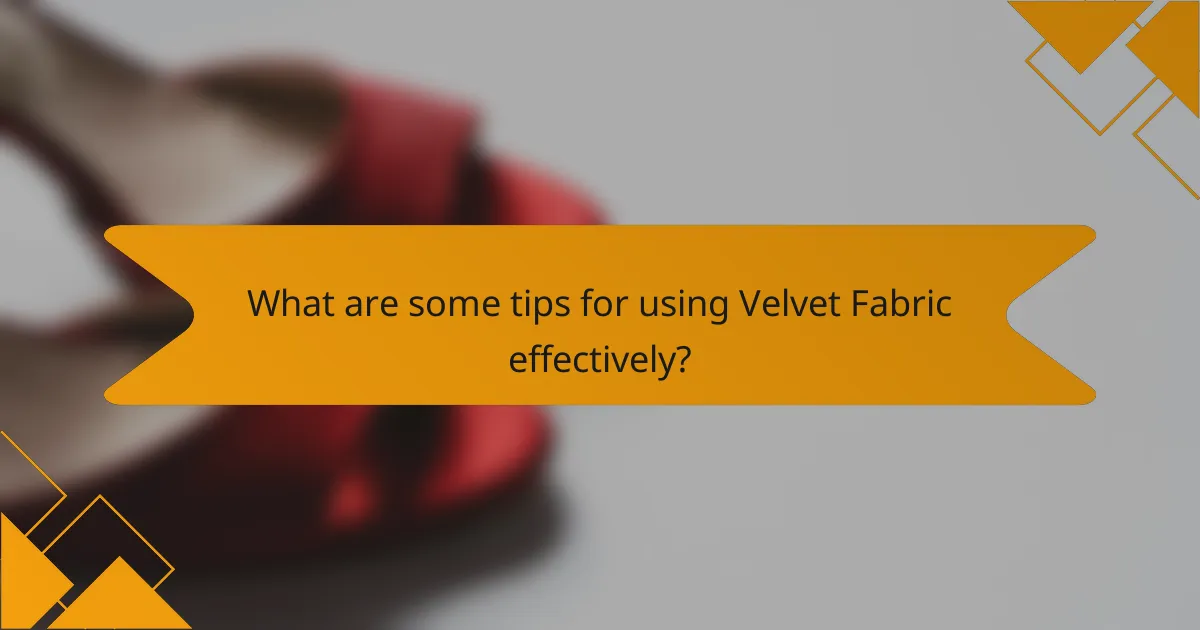
What are some tips for using Velvet Fabric effectively?
To use velvet fabric effectively, start by selecting the right type for your project. Different velvet types, such as crushed or stretch velvet, serve various purposes. Always pre-wash velvet to prevent shrinkage and maintain its texture. When cutting velvet, use sharp scissors to avoid fraying and ensure clean edges. For sewing, use a walking foot to manage the fabric’s thickness and prevent slipping. Iron velvet on a low heat setting with a pressing cloth to avoid damage. Store velvet in a cool, dry place to maintain its quality. These tips help achieve professional results with velvet fabric.
What styling tips can enhance the appearance of Velvet Fabric?
Choose complementary colors to enhance velvet fabric’s richness. Jewel tones like emerald and sapphire work well. Pair velvet with lighter fabrics to create contrast. This highlights velvet’s texture and depth. Use accessories like metallics to add sophistication. Layer velvet with other materials for visual interest. Opt for tailored cuts to maintain structure. Ensure proper lighting to showcase the fabric’s sheen. Velvet appears more vibrant in natural light.
What are common mistakes to avoid when using Velvet Fabric?
Common mistakes to avoid when using velvet fabric include improper cleaning methods. Velvet is delicate and often requires dry cleaning. Using water can lead to water stains and damage the fabric’s texture. Another mistake is ignoring the direction of the pile. Velvet has a nap that should be brushed in one direction for a uniform appearance. Failing to protect velvet from sunlight can cause fading over time. Additionally, neglecting to use appropriate upholstery techniques can result in wear and tear. Lastly, placing heavy objects on velvet can crush the fibers, leading to permanent marks. Each of these mistakes can significantly impact the longevity and appearance of velvet fabric.
How can you troubleshoot issues with Velvet Fabric maintenance?
To troubleshoot issues with velvet fabric maintenance, first identify the specific problem. Common issues include stains, crushing, and fading. For stains, gently blot the area with a clean cloth and mild detergent. Avoid rubbing the fabric, as it can damage the fibers. For crushing, use a soft brush to restore the pile. Brush in the direction of the nap for best results. If fading occurs, keep velvet out of direct sunlight to prevent further damage. Regular vacuuming with a soft brush attachment can help maintain the fabric’s appearance. These methods are effective in preserving the quality and look of velvet fabric.
Velvet fabric is a luxurious textile characterized by its soft texture and sheen, made through a unique weaving process that creates a dense pile. This article explores the various types of velvet, including silk, cotton, and polyester, along with their distinct attributes and applications in fashion, upholstery, and home décor. It also covers the maintenance and cleaning methods necessary to preserve velvet’s quality, as well as tips for effective use and styling. Additionally, the piece addresses common mistakes to avoid and troubleshooting techniques for maintaining velvet fabric.
